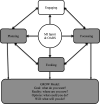Behaviour change, the itchy spot of healthcare quality improvement: How can psychology theory and skills help to scratch the itch?
- PMID: 37746584
- PMCID: PMC10517624
- DOI: 10.1177/20551029231198938
Behaviour change, the itchy spot of healthcare quality improvement: How can psychology theory and skills help to scratch the itch?
Abstract
Despite the clear utility and transferability, National Health Service (NHS) quality improvement initiatives have yet to benefit fully from what is already known within health psychology. Thus far, evidence from established, seminal behaviour change theory and practice have been ignored in favour of newly developed models and frameworks. Further, whilst there is a growing interest in what is commonly referred to as 'human factors' of change and improvement, there is scant transferability of known psychologically informed implementation skills into routine NHS Improvement practice. The science and practice of healthcare improvement is growing, and the behaviour change aspect is critical to sustainable outcomes. Therefore, this paper offers practical guidance on how seminal psychological behaviour change theory and motivational interviewing (a person-centred skills-based approach specifically developed to support people through change) can be combined to better address individual and organisational change within a healthcare improvement context.
Keywords: NHS; behaviour change; healthcare; motivational interviewing; psychology; quality improvement.
© The Author(s) 2023.
Conflict of interest statement
The author(s) declared no potential conflicts of interest with respect to the research, authorship, and/or publication of this article.
Figures







Similar articles
-
Critical Care Network in the State of Qatar.Qatar Med J. 2019 Nov 7;2019(2):2. doi: 10.5339/qmj.2019.qccc.2. eCollection 2019. Qatar Med J. 2019. PMID: 31763205 Free PMC article.
-
Acute post-stroke aphasia management: An implementation science study protocol using a behavioural approach to support practice change.Int J Lang Commun Disord. 2023 May;58(3):968-976. doi: 10.1111/1460-6984.12816. Epub 2022 Dec 15. Int J Lang Commun Disord. 2023. PMID: 36523127
-
The Effectiveness of Motivational Interviewing on Glycemic Control for Adults with Type 2 Diabetes Mellitus (DM2): A Systematic Review.JBI Libr Syst Rev. 2012;10(42 Suppl):1-17. doi: 10.11124/jbisrir-2012-246. JBI Libr Syst Rev. 2012. PMID: 27820150
-
Towards developing a comprehensive conceptual understanding of positive hospital culture and approaches to healthcare organisational culture change in Australia.J Health Organ Manag. 2021 Apr 13;ahead-of-print(ahead-of-print). doi: 10.1108/JHOM-10-2020-0385. J Health Organ Manag. 2021. PMID: 33837683 Review.
-
Training diabetes healthcare practitioners in motivational interviewing: a systematic review.Health Psychol Rev. 2022 Sep;16(3):430-449. doi: 10.1080/17437199.2021.1926308. Epub 2021 May 24. Health Psychol Rev. 2022. PMID: 33970799
Cited by
-
Effect of Motivational Interviewing and Exercise on Chronic Low Back Pain: A Systematic Review and Meta-Analysis.Musculoskeletal Care. 2025 Mar;23(1):e70048. doi: 10.1002/msc.70048. Musculoskeletal Care. 2025. PMID: 39743340 Free PMC article.
References
-
- Abraham C, Michie S. (2008) A taxonomy of behavior change techniques used in interventions. Health Psychology 27(3): 379–387. - PubMed
-
- Ajzen I. (1991) The theory of planned behavior. Organizational Behavior and Human Decision Processes 50(2): 179–211.
-
- Amrhein PC, Miller WR, Yahne CE, et al. (2003) Client commitment language during motivational interviewing predicts drug use outcomes. Journal of Consulting and Clinical Psychology 71(5): 862–878. - PubMed
-
- Andersson AC, Olheden A. (2012) Patient participation in quality improvement: managers’ opinions of patients as resources. Journal of Clinical Nursing 21(23–24): 3590–3593. - PubMed
-
- Appelbaum SH, Habashy S, Malo J, et al. (2012) Back to the future: revisiting Kotter’s 1996 change model. The Journal of Management Development 31(8): 764–782.
LinkOut - more resources
Full Text Sources
Research Materials

